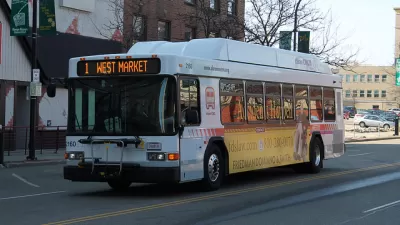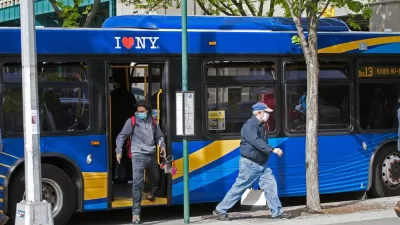Omaha sets out to prove that strong transit isn't just "a Portland thing or a New York thing."
Eric Jaffe examines Omaha as a case study of a low-density city in the heartland beginning to embrace transit—and making smart moves to take advantages of its opportunities to do so.
First Jaffe notes that Omaha is far from the kind of dense urban environment that transit requires to thrive. Thus, the "city's Metro bus system averages just 18 boardings per revenue-hour, and only two of its 34 lines run every 15 minutes—the minimum threshold for show-up-and-go service."
But in addition to incremental improvements like increased population downtown and a bar shuttle recently launched by a microtransit start-up, the city is also moving forward with a sweeping overhaul of its bus network.
"At the end of May, Metro will debut its FORWARD plan: a fully reconfigured bus network that emphasizes more frequency, better night and weekend service, direct lines through high-ridership corridors, and grid-style access to many parts of the city. The top five routes will now all get 15-minute peak service, and there's a new max wait time of an hour across the system—down from 90-to-120 minutes."
Jaffe provides a lot more detail about the plan and its impacts, including maps and infographics to illustrate those points. Also of note, regarding the future of transit in Omaha, is that the Metro Forward plan also sets the stage for a bus rapid transit line, funded by a $15 million TIGER grant awarded in September. The city expects to launch an eight-mile BRT line by 2018.
FULL STORY: Omaha Just Designed a Way Better Transit System for Zero Cost

Alabama: Trump Terminates Settlements for Black Communities Harmed By Raw Sewage
Trump deemed the landmark civil rights agreement “illegal DEI and environmental justice policy.”

Planetizen Federal Action Tracker
A weekly monitor of how Trump’s orders and actions are impacting planners and planning in America.

The 120 Year Old Tiny Home Villages That Sheltered San Francisco’s Earthquake Refugees
More than a century ago, San Francisco mobilized to house thousands of residents displaced by the 1906 earthquake. Could their strategy offer a model for the present?

In Both Crashes and Crime, Public Transportation is Far Safer than Driving
Contrary to popular assumptions, public transportation has far lower crash and crime rates than automobile travel. For safer communities, improve and encourage transit travel.

Report: Zoning Reforms Should Complement Nashville’s Ambitious Transit Plan
Without reform, restrictive zoning codes will limit the impact of the city’s planned transit expansion and could exclude some of the residents who depend on transit the most.

Judge Orders Release of Frozen IRA, IIJA Funding
The decision is a victory for environmental groups who charged that freezing funds for critical infrastructure and disaster response programs caused “real and irreparable harm” to communities.
Urban Design for Planners 1: Software Tools
This six-course series explores essential urban design concepts using open source software and equips planners with the tools they need to participate fully in the urban design process.
Planning for Universal Design
Learn the tools for implementing Universal Design in planning regulations.
Clanton & Associates, Inc.
Jessamine County Fiscal Court
Institute for Housing and Urban Development Studies (IHS)
City of Grandview
Harvard GSD Executive Education
Toledo-Lucas County Plan Commissions
Salt Lake City
NYU Wagner Graduate School of Public Service





























